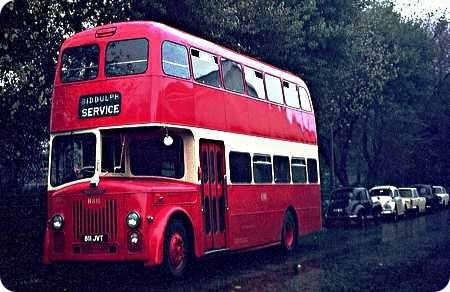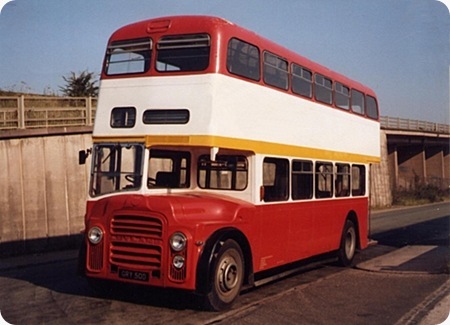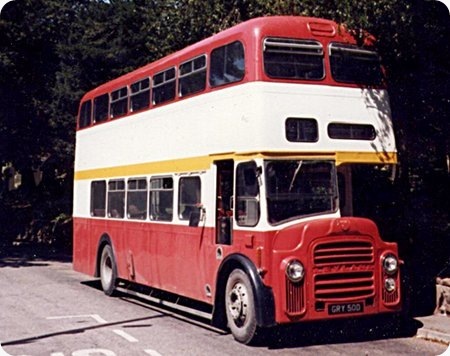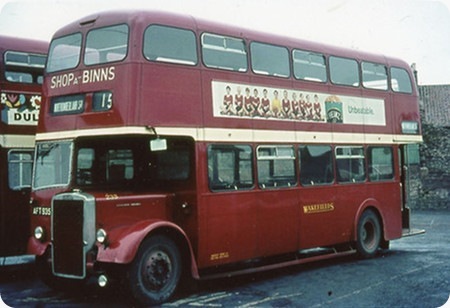PMT – Leyland Titan PD3 – 811 JVT – H811
Potteries Motor Traction
1960
Leyland Titan PD3/3
Willowbrook H39/34F
This was the last front engined bus delivered to PMT and was ordered by Baxters of Hanley who had sold out to PMT in December 1958. The Leyland PD/Willowbrook combination was clearly Baxters preferred design following on from the two Leyland PD2/20 supplied in 1955 and 1957. These two were of lowbridge layout (indeed as were all the double deckers taken over) and was also PMT’s preference due to the significant number of low railway bridges in the area. I wonder why then Baxters ordered this bus as a highbridge? The main batch of PD3s delivered to PMT had exposed radiators and this bus was one of only two delivered new with BMMO style concealed radiators. The other oddity was the vacuum braked specification which from discussions on this site about the stopping powers of PD3s would make this one even worse – but I can’t recall any driver complaints. It spent almost all its life operating from Biddulph Depot where I suppose the small number of drivers would be more likely to accept its idiosyncrasies. The bus is seen outside Stoke Depot in October 1969. It was withdrawn in 1971 and found its way inevitably to a Barnsley scrapyard.
Photograph and Copy contributed by Ian Wild
A full list of Titan codes can be seen here.
———
21/11/12 – 06:51
I appreciate that ‘Bus Lists On The Web’ gives the seating as H39/34F, but 34 seems incredibly high for the lower deck capacity – the normal maximum for a 30′ front-engined forward-entrance double-decker being 31. Anyone any first-hand experience of this bus?
Another thing I find surprising is the statement that it ‘inevitably’ found its way to a Barnsley scrapyard – high-capacity front-entrance double-deckers were almost unknown on the secondhand market in 1971, and I can’t help but think that there must have been a reason for this vehicle’s early withdrawal and scrapping.
David Call
———
21/11/12 – 14:47
I think you’re correct David, considering that PMT’s own PD3/4’s dated from 1957 and lasted a couple of years longer than this one. As you say, this would have made a sought after secondhand vehicle in 1971 and would perhaps have been snapped up by someone such as Berresfords of Cheddleton had it been sound. Berresfords did in fact acquire some ex-PMT PD3/4’s in 1973.
Chris Barker
———
21/11/12 – 17:30
After an accident too serious to warrant repair, perhaps? Then either directly to Barnsley or after spares recovery. I’d imagine there’s something in an issue of BUSES ILLUSTRATED of the time, if anyone has a copy.
Pete Davies
———
22/11/12 – 07:20
An even better source of information would be PSV Circle publication 3PD1 – PMT fleet history 1953-82
David Call
———
22/11/12 – 11:55
According to the book ‘A Century of North Staffordshire Buses’ this PD3 was ordered by Baxters as a lowbridge vehicle in 1958. Baxters were acquired by PMT in December 1958 and they were in time to change the specification to highbridge. Presumably it was originally intended to be rear entrance because I don’t think Willowbrook ever produced a 30ft lowbridge front entrance body, so perhaps the vehicle that we see was the best option for PMT, if they didn’t want another back loader.
It appears to have been a normal withdrawal by PMT in December 1971 and after passing to Cowleys, was cut up for scrap. The ex-Becketts Northern Counties bodied Fleetline was withdrawn by PMT when only ten years old!
Chris Barker
Quick links to the - Comments Page - Contact Page - Home Page




